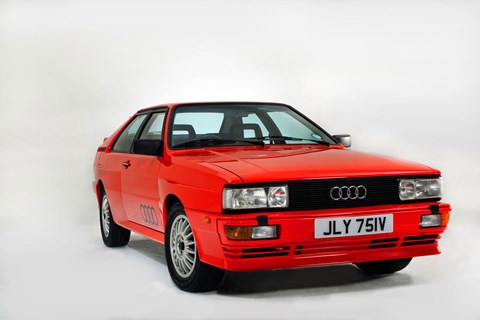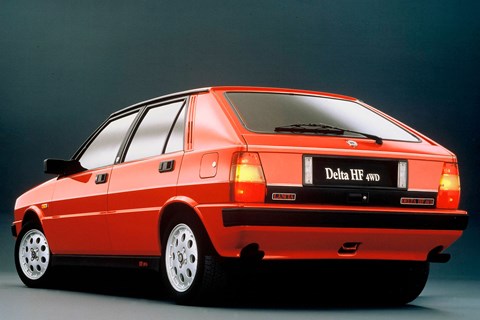► Seven years after it started the 4wd trend, is Quattro still king?
► Lancia’s then-new 4wd Delta looks to take the Audi’s crown
► A head-to-head comparison test from December 1986
The Quattro is no longer young, strong in limb though it undoubtedly still is. It has resisted all pretenders – until now…
It is now bottom-line time. How does the £12,000 four-wheel-drive Delta HF Turbo measure up to the car that started the trend, the car and concept that sent wrong-footed product planners scurrying for their slide rules seven years ago: the Audi Quattro? The Lancia may be a better tool than the Mazda, but can it cope with the big one? In fact, the Delta is the only 4×4 that genuinely rivals the Quattro’s capabilities even though it is several sizes smaller than the German machine. The BMW 325i 4×4, the all-wheel-drive Sierras and Granadas – none quite matches the performance of the Lancia.
To find out how matters stand, we take a Quattro with us to Somerset along with the Mazda and Lancia. We punt it around Castle Combe, we thunder across Exmoor in it and we stretch it at Millbrook, the General Motors proving ground near Luton. And, in the end, we come to the rather startling conclusion that the Delta is the better car. Not vastly superior – it has too many faults for that – but in our eyes, it scores enough points to nose ahead of the Quattro, especially for the promised price of less than half the Audi’s £25,592 tag.
The Quattro wins immediate points on the first day’s drive by turning in a 1min 19.1sec lap of Castle Combe, well ahead of the Lancia’s 1min 21.5sec. The Audi wins here mainly because of its crushing performance advantage – it has 156bhp per ton to the Lancia’s 137.
So does the German’s superior grip – no surprise really, given its colossal 215/50 VR15 tyres. Ultimately, though, it’s the least tidy handler of the trio. Its basic urge is to understeer, and the suspension can deter it from such behaviour for only so long. Eventually it runs wide, though it doesn’t maul its outside front tyres quite as mercilessly as does the Lancia. It also turns in better than the Italian, changing direction with a zeal that belies its bulk, especially at lower speeds. Indeed, the Quattro’s agility has a slightly artificial feel to it, as if some quirk of its suspension geometry allows it to overcome the laws of physics.
For all this, the Audi is pretty entertaining on the track, not least because of its exceptionally communicative steering. The Delta’s seems lifeless by comparison. The downside is that the Quattro darts and weaves under heavy braking on most surfaces, but at least you feel as if you’re driving a sporting machine, even if it isn’t as handy as the Mazda.

Then again, the Audi’s safer in extremis, never kicking out its tail if you let the accelerator spring back – it gently sharpens its line instead. The Audi’s brakes are reassuring, too, feeling more potent than the other pair’s, although you have to press harder. You also have to expend more effort at the wheel. Around Castle Combe the Quattro may be quicker, but it’s a more demanding car to drive than the Delta.
And, on the motorway haul down to Somerset, it becomes clear that the Quattro’s more tiring, too. The reason comes as a shock – it makes far more noise. There’s a constant roar from the fat tyres, the engine drones slightly more audibly than the Lancia’s (though never as intrusively as the Mazda’s) and there’s a constant rumbling chorus from the drive system.
The Quattro doesn’t ride that well on the motorway either, failing to obliterate bumps that would give most cars no trouble at all. On the other hand, its damping at least is consistent – in the Delta, you drive for miles and think the ride is supple, then hit a few bumps and conclude that it has a no more absorbent system than a Morris Ital.
The following day, on the moors, a few of the Quattro’s more notable drawbacks become apparent. The most obvious is that it’s a bit big for the roads round there – there’s room for the oncoming traffic, but not much margin for error. And with the wheel constantly writhing as the tyres dip into craters and crest hummocks, you find yourself having to work hard to keep it on the left side of the white line.
In the Delta, such troubles are absent – you hardly ever have to re-route the car because of bumps, and you have more leeway to alter an angle of attack, because it’s narrower. But there’s more to it than that. The Lancia has the more tractable powertrain, a decisive factor on these Somerset roads. With its engine hard at work from as little as 2000rpm, the Lancia can be off and away while the Audi driver is slipping down a gear to harness his car’s top end zest. The Quattro may be less peaky than the Mazda, but there’s no question that its engine pumps harder once it’s around the 3000rpm mark.
The Quattro is also quicker (the 50-70mph sprint is demolished in 4.8sec, to the Delta’s 5.9sec) but it’s an effort to be in the right gear ratio at the right time, not so much because the Audi has a poor gearchange (it’s as accurate as the Italian’s but not as smooth) but because its peaky engine and sharp clutch make seamless gearchanges something of an art to achieve.
Being in the right gear at the right time calls for thought as well as dexterity because the Quattro’s bizarrely chosen ratios guarantee that you’ll be reaching for the gearlever pretty often if you’re not to experience the on/off intrusion of the turbocharger. The Audi’s ratios feel even odder after you’ve tried the Delta’s, which allow you to swoop from curve to curve while keeping both hands on the wheel nearly all the time.

This combination of factors has the Lancia edging away for much of our time on the moors. It’s not that the Audi doesn’t have the power reserves to catch it – it’s just that funnelling its bulk down these roads (which are no narrower than the average British B-road) is a bit of a heart-in-mouth exercise.
We give the Audi full throttle far less often than we do the Lancia for these reasons. But do not doubt that it’s a supremely fast car. It can hit 100mph in 19.6sec, against the Lancia’s 21.9sec, and storm on to a slightly higher top speed of 134.5mph. Interestingly, though, the Quattro can’t quite crack the 7.0sec barrier to 60mph (it manages 7.1sec), because you need two snatches at the gearlever along the way.
But, on more open routes, empty A-roads, and sinuous autobahnen, the Quattro would gradually steal away, its extra power and grip making themselves felt. The Delta, however, can play one more trump card. When we really push it on that last day on Exmoor, we discover that it will turn more neutrally, its back axle, with its torsion differential, shovelling the car through bends. When it’s driven really hard, the Delta’s understeer is neutralised, and you can work it even harder. But try that in the Audi (if you dare – you’d need to be travelling at a terrific pace) and it would want to plough off.
But then the Quattro doesn’t have a torsen differential. Nor does it have a Ferguson viscous coupling, or an oversize engine for its body. It’s an old car now, the Audi, seven years into a career that will last until 1988. Then it will be replaced by a machine with 240bhp (today’s has 200bhp), a torsen rear diff, a lower Cd that should give it a higher top speed, less weight, and a more rounded style.
The Quattro has many appeals – glamorously brutal good looks, excellent build quality (its paintwork is deeper and far more lustrous than the Lancia’s), fine seats, and terrific all-out grip and go. But its age is starting to show. Its drawbacks – the peaky power curve, the noise, the joggly ride, the strange gearing, the ultimate understeer – and the price differential – all these allow the Delta to sneak under the wire and get the nod. For the moment.
Read more CAR archive tests